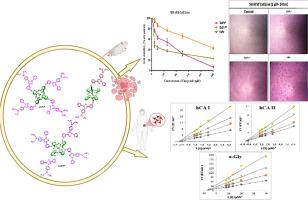细胞毒活性对神经母细胞瘤和小鼠成纤维细胞系,在硅分子模型研究和轴向硅酶活性,包括外周和非外周锌酞菁
IF 2.1
3区 化学
Q3 CHEMISTRY, INORGANIC & NUCLEAR
引用次数: 0
摘要
采用MTT法评价轴向二取代酞菁硅(SiPc)和外周和非外周取代酞菁锌(ZnPcp/np)对神经母细胞瘤(SH-SY5Y)和小鼠成纤维细胞(NIH-3T3)的细胞毒性作用。所有被评估的药物对SH-SY5Y细胞均有明显的细胞毒性影响,其IC50值远低于NIH-3T3细胞,后者的IC50值最高。这些结果表明,产生的酞菁(SiPc, ZnPcp/np)可能是治疗神经母细胞瘤的有效、特异性和有希望的治疗候选者。此外,还测定了这些化合物(SiPc, ZnPcp/np)对α-葡萄糖苷酶和hCA I和II同工酶的活性,这些化合物作为抑制剂被开发用于治疗糖尿病、癌症、青光眼、肥胖和癫痫等疾病。结果表明,SiPc、ZnPcp/np比阿卡波糖(IC50: 4.58µM)具有更强的α-葡萄糖苷酶抑制作用。在hCA I酶蛋白(PDB ID: 2CAB)、hCA II酶蛋白(PDB ID: 3DC3)、α-Gly酶蛋白(PDB ID: 1UAS)和SH-SY5Y细胞蛋白(PDB ID: 3PBL、7CKZ和7LQZ)等一系列蛋白上,对酞菁前体分子二腈衍生物(CNp/np)和金属配合物(SiPc、ZnPcp/np)进行了分子对接计算。本文章由计算机程序翻译,如有差异,请以英文原文为准。

Cytotoxic activity against neuroblastoma and mouse fibroblast cell lines, in silico molecular modeling studies and enzyme activity of axial silicon, both peripheral and non-peripheral zinc phthalocyanines
The cytotoxic effects of axial disubstituted silicon phthalocyanine (SiPc) and both peripheral and non-peripheral substituted zinc phthalocyanines (ZnPcp/np) were evaluated on neuroblastoma (SH-SY5Y) and mouse fibroblast (NIH-3T3) cell lines utilizing the MTT assay. All evaluated drugs had a pronounced cytotoxic impact on SH-SY5Y cells, with IC50 values much lower than those observed in NIH-3T3 cells, which displayed the highest IC50 values. These results imply that produced phthalocyanines (SiPc, ZnPcp/np) may be effective, specific, and promising therapeutic candidates for the treatment of neuroblastoma. In addition, the activities of these compounds (SiPc, ZnPcp/np) on α-glucosidase and hCA I and II isozymes, which were developed as inhibitors in the treatment of diseases such as diabetes, cancer, glaucoma, obesity, and epilepsy, were also determined. The results obtained proved that these compounds (SiPc, ZnPcp/np) were more potent α-glucosidase inhibitors than Acarbose (IC50: 4.58 µM), which was used as a positive control. Molecular docking calculations of dinitrile derivatives (CNp/np), which are precursor molecules for phthalocyanines, and metal complexes (SiPc, ZnPcp/np) were performed on a series of proteins, including hCA I enzyme protein (PDB ID: 2CAB), hCA II enzyme protein (PDB ID: 3DC3), α-Gly enzyme protein (PDB ID: 1UAS), and SH-SY5Y cell protein (PDB ID: 3PBL, 7CKZ, and 7LQZ).
求助全文
通过发布文献求助,成功后即可免费获取论文全文。
去求助
来源期刊

Journal of Organometallic Chemistry
化学-无机化学与核化学
CiteScore
4.40
自引率
8.70%
发文量
221
审稿时长
36 days
期刊介绍:
The Journal of Organometallic Chemistry targets original papers dealing with theoretical aspects, structural chemistry, synthesis, physical and chemical properties (including reaction mechanisms), and practical applications of organometallic compounds.
Organometallic compounds are defined as compounds that contain metal - carbon bonds. The term metal includes all alkali and alkaline earth metals, all transition metals and the lanthanides and actinides in the Periodic Table. Metalloids including the elements in Group 13 and the heavier members of the Groups 14 - 16 are also included. The term chemistry includes syntheses, characterizations and reaction chemistry of all such compounds. Research reports based on use of organometallic complexes in bioorganometallic chemistry, medicine, material sciences, homogeneous catalysis and energy conversion are also welcome.
The scope of the journal has been enlarged to encompass important research on organometallic complexes in bioorganometallic chemistry and material sciences, and of heavier main group elements in organometallic chemistry. The journal also publishes review articles, short communications and notes.
 求助内容:
求助内容: 应助结果提醒方式:
应助结果提醒方式:


